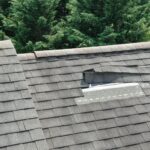Hedge fund Fermat Capital Management expects the market for catastrophe bonds to grow 20% this year, as a product based on disasters gains ground in a world increasingly shaped by extreme weather, population density and inflation.
The market “has reached an inflection point,” John Seo, managing director and co-founder of Fermat, said in an interview.
“The key thing is inflation,” he said, which is making it substantially more expensive in Europe and the US to rebuild property that’s been destroyed by natural catastrophes.
Read more: Catastrophe Bonds Among Few Asset Classes Withstanding Meltdown
Fermat’s growth prediction means the market for cat bonds, which are typically issued by insurers looking to offload extreme risk to capital markets, will reach roughly $60 billion by the end of 2025.
The bonds have outperformed other high-yield markets in recent years, and even managed to sail through the turbulence triggered by US President Donald Trump’s tariff war. Against that backdrop, a product that was once the preserve of highly sophisticated investors is now luring a wider array of buyers.
Fermat is among firms that have started offering access to cat bonds via UCITS funds, a product that opens the door to retail investors. And this year saw the introduction of the world’s first exchange-traded fund based on cat bonds.
Investors in cat bonds stand to lose their capital if a predefined catastrophe occurs, but can reap huge rewards if it doesn’t. If payouts aren’t triggered by a natural catastrophe, the bonds are structured so that they do well when Treasury yields rise. Over the past year, they’ve returned about 14%, according to an index compiled by Swiss Re.

“It’s been a pretty benign period for catastrophe bonds,” said Maria Dobrescu, a senior principal at Morningstar Inc.
Market growth has come with a degree of realignment. Last month, Fermat was suddenly ejected from a two-decades-long agreement with GAM Holding AG to co-manage a $3 billion portfolio of cat bonds. The Zurich-based asset manager is instead teaming up with a unit of Swiss Re, a major issuer of cat bonds, to oversee the funds.
GAM’s decision to end its agreement with Fermat was followed by a significant adjustment in flows between the two firms. Between the end of March and the end of April, cat-bond funds managed by Fermat received new client money equivalent to about $1.1 billion, while GAM funds saw close to $1.2 billion in client redemptions.
Rom Aviv, head of insurance-linked securities at GAM, said earlier this month that redemptions are “very common during periods of structural transition and a manager change.” But GAM’s partnership with Swiss Re is now generating client interest, he said.
Seo said at the time that clients “expressed understandable alarm” at GAM’s “sudden and unilateral” decision to end its relationship with Fermat.
Swiss Re has said it sees the development as an opportunity to target more innovation and product growth.
“The market is growing not just in size, but in breadth and diversification in terms of sponsors and in the types of risk that is being transferred,” said Christopher Minter, head of Swiss Re Alternative Capital Partners.
Seo says Swiss Re “is signaling a new level of seriousness and we welcome that,” adding that “the investor pie is growing so rapidly there’s enough business for everybody.”
Achieving Scale
GAM’s partnership with Swiss Re brings the reinsurer’s portfolio of insurance-linked securities (ILS) to $6.9 billion, including $3.7 billion in cat bonds.
“I’d be very disappointed if we aren’t unequivocally one of the leaders of the ILS market in the short to medium term,” Minter said.
Fermat oversees a $10 billion portfolio of mostly cat bonds, while Twelve Securis — a firm that’s the product of a recent merger between Twelve Capital and Securis — manages $8.5 billion of ILS assets, including $6 billion in cat bonds and the rest in private ILS deals.
Etienne Schwartz, chief investment officer of liquid securities at Twelve Securis, said scale allows an asset manager to better handle the complexity of cat-bond portfolios, including areas such as specialized risk modeling to compliance and fund distribution.
“To attract institutional investors, you need size,” he said.
Regulators have been encouraging growth in the ILS market. The European Central Bank and the European Insurance and Occupational Pensions Authority have called for increased use of cat bonds in the EU, where only about a quarter of climate-related catastrophe losses are currently insured. In the UK, the Prudential Regulation Authority recently proposed cutting approval times for “insurance special purpose vehicles” to 10 days from the current 4-6 weeks.
“The UK ISPV regime has seen limited uptake since its introduction in 2017,” the PRA said in November. “Due to the importance of speed in this market, a faster authorization means a quicker time to market for certain UK ISPVs such as cat bonds.”
Cat bonds emerged from last year’s hurricane season relatively unscathed. Meteorologists are predicting this year’s Atlantic hurricane season will be more active than usual, with the possibility of three to five major storms.
Morningstar’s Dobrescu says climate change is making it harder for cat-bond models to capture the full range of risks ahead.
“Some of the extrapolations may not hold,” she said. “Longer term, it’s difficult to know where the absolute returns will land.”
Swiss Re plans to navigate the uncertainty by leveraging the 190 proprietary peril models it runs. The firm also has 50 in-house scientists who specialize in catastrophe risk.
Mariagiovanna Guatteri, chief executive officer of Swiss Re Insurance-Linked Investment Advisors Corp., said any concerns around conflicts of interest — with Swiss Re both an issuer and fund manager of cat bonds — are unfounded.
There are “very strict policies and procedures” in place to keep those functions separate, she said.
In the meantime, the market keeps growing.
“Cat bonds are filling in the gap between the extra demand for reinsurance and the reduced capacity for reinsurance companies to absorb that risk,” Seo said. And the big driver behind that development is the rising price of rebuilding after catastrophe strikes.
“Inflation has increased the underlying risk exposure by 50% in nominal dollars over the previous five years,” he said.
What Bloomberg Intelligence Says…
The cat bond market has doubled in size over the past decade, with retail investors in catastrophe bond funds in the Undertakings for Collective Investment in Transferable Securities (UCITS) format rising to a 30% share of the market as of 1Q from 12% in 2015.
Top photograph: A downed tree and blocked-in vehicle after hurricanes Helene and Milton in St. Pete Beach, Florida, in October 2025; Photo credit: Tristan Wheelock/Bloomberg
Topics Catastrophe
Was this article valuable?
Here are more articles you may enjoy.



 Court Ruling Could Help Shed Light on Owners of Litigation Funders, Medical Clinics
Court Ruling Could Help Shed Light on Owners of Litigation Funders, Medical Clinics  Three Top P/C Insurers Account for Most of Insurance AI Patents
Three Top P/C Insurers Account for Most of Insurance AI Patents  Aon Adds to List of Brokers Suing Howden US for Alleged Poaching, Theft
Aon Adds to List of Brokers Suing Howden US for Alleged Poaching, Theft  North Carolina Sting Operation Alleges Roofer Damaged Shingles to File Claim
North Carolina Sting Operation Alleges Roofer Damaged Shingles to File Claim 

